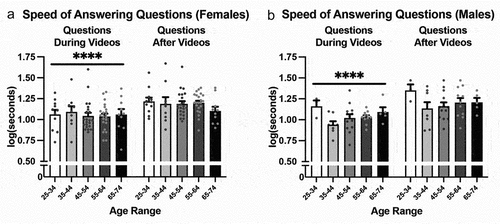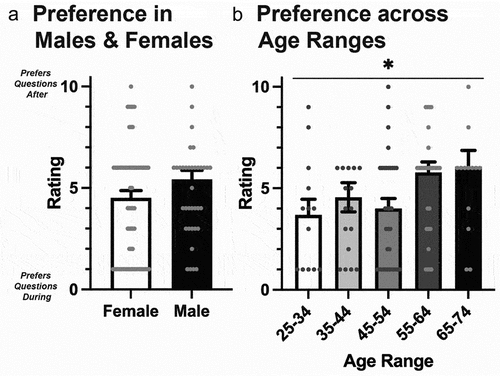Figures & data
Figure 1. Speed of answering questions: both females (a; n= 74) and males (b; n=40) answered questions faster when they were positioned during videos than after videos (****,p<0.0001). The speed of answering questions was normalised vis log transformation. Bars represent age ranges (±SEM) and individual data points (grey circles) are shown.

Table 1. Overall comparison of attitudes to questions asked during vs after videos (ages and gender identities combined). Results show averages (out of 10; ±SEM) and Wilcoxon test statistics (Z & p). n = 114; *, p < 0.05.
Figure 2. Comparison of attitudes to questions asked during vs after videos between males (n = 40) and females (n = 74). Statistics are presented in . Survey responses are scored out 10. Females are shown in white bars and males in black (±SEM). Grey circles represent individual data points. *, p < 0.05.

Table 2. Comparison of attitudes to questions asked during vs after videos between males (n = 40) and females (n = 74). Results are also presented in . Mann-Whitney test statistics are shown in this table (U & p). *, p < 0.05.
Figure 3. Comparison of attitudes to questions asked during vs after videos across ages [25–34 (n=14), 35–44 (n=17), 45–54 (n=35), 55–64 (n=33), and 65–74 (n=15)]. Statistics are presented in . Survey responses are scored out 10. Bars represent average scores (±SEM). Grey circles represent individual data points. *, p<0.05.
![Figure 3. Comparison of attitudes to questions asked during vs after videos across ages [25–34 (n=14), 35–44 (n=17), 45–54 (n=35), 55–64 (n=33), and 65–74 (n=15)]. Statistics are presented in Table 3. Survey responses are scored out 10. Bars represent average scores (±SEM). Grey circles represent individual data points. *, p<0.05.](/cms/asset/e11c33f6-e6a0-4e11-8947-07384be82ddf/tled_a_2196449_f0003_b.gif)
Table 3. Comparison of attitudes to questions asked during vs after videos across age groups [25–34 (n = 14), 35–44 (n = 17), 45–54 (n = 35), 55–64 (n = 33), and 65–74 (n = 15)]. Results are also presented in . Kruskal-Wallis H tests with Dunn multiple-comparison tests (for specific age ranges) are shown in this table. *p < 0.0001–0.05.

